I absolutely loved growing and eating cherry tomatoes last year, and for 2024 my main gardening goal was to improve my tomato-growing skills. Living in Canada, the growing season is short, so I have to make the most of it before we’re back to snow! But the more you discover about gardening, the more you realise how much there is still to learn: so many varieties of tomato, so many different ways to grow them, and so much conflicting advice… How do you decide who to believe and which advice to follow?
Thanks to my science background, my answer is always to do my own experiments and see what actually works best for me! So I decided to try a lot of different things in my 2024 garden, and build what I learn into a solid plan for my future tomatoes. I filled my garden with 22 tomato plants of 12 different varieties (plus 2 more plants kept indoors).
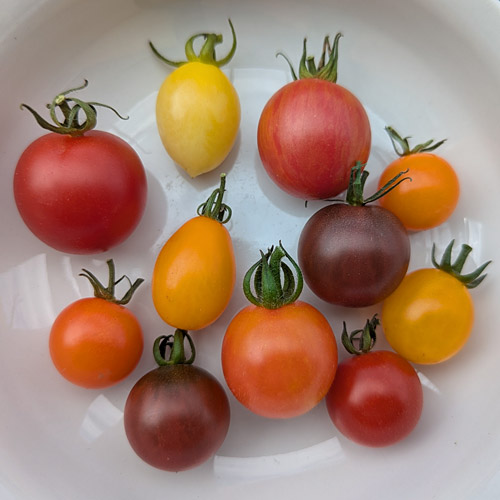 A selection of the cherry tomatoes I grew in 2024
A selection of the cherry tomatoes I grew in 2024
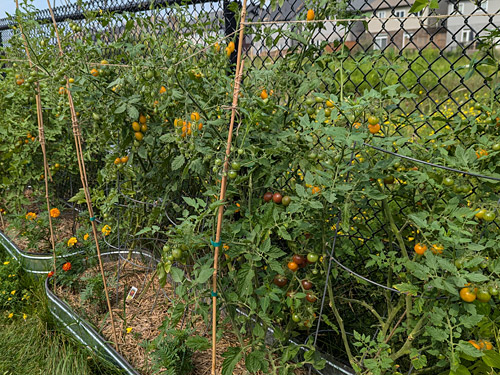 And here’s a small part of my tomato jungle!
And here’s a small part of my tomato jungle!
Of course, I’m not saying my results are the definitive answers – I’m not an expert, and with only one plant to compare in each experiment, my results aren’t statistically significant. But I wanted to document everything for myself, and who knows? Maybe you’ll find some of it interesting or even helpful if you want to try growing cherry tomatoes like these!
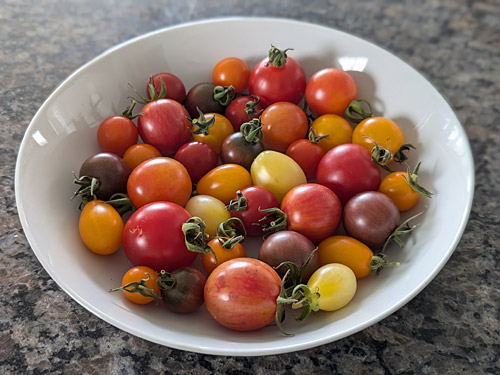
For each of my experiments, I used the same type of tomato for both cases and tried to only change the variable I was testing for to give a fair comparison. There are too many other factors at play to make this a scientifically valid test, but I’ve still learnt a lot from trying so many things this season! Read on to find out what I discovered…
Growing from Seeds or Started Plants
Buying started plants vs growing from seed
My home-started seedlings were much thinner and taller than the compact starts I bought from a local nursery, and had smaller roots. (I learnt a lot from this year’s attempts and, next year, I’m aiming to match nursery quality.) While my home-started plants never quite caught up to the boost given by the stronger nursery plants, both produced plenty of tomatoes and were equally tasty.
Verdict: Buying strong seedlings from a nursery is much easier and more likely to give great results. But, if you have a good setup (plenty of light is critical) and are willing to tend seedlings for a couple of extra months, starting seeds can save money and let you try uncommon varieties.
Is there an advantage to starting seeds earlier than recommended?
I started some seeds 2 months early and transplanted them alongside the standard-start tomatoes. The early plants grew tall and leggy, and I had to pot them up and support them with bamboo canes while they were still indoors. While the early plants did fruit earlier, the fruit only ripened 2 weeks before the standard plants, and the tomatoes were much smaller.
Verdict: Harvesting tomatoes early sounds great, but it’s not worth the hassle of months spent caring for overgrown plants indoors! Stick to the planting date on the seed packet for healthier plants and better results.
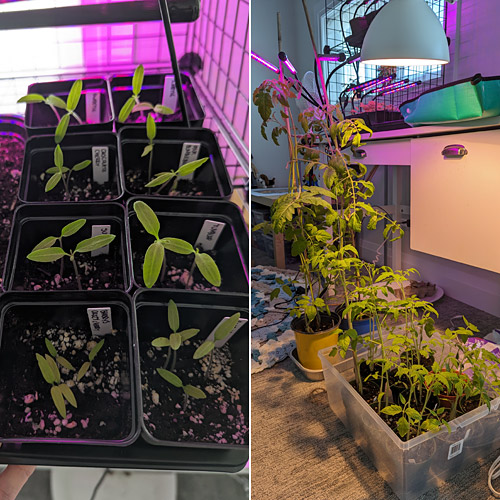 Left: baby seedlings. Right: starting some seeds too early (pots at back) meant caring for 3-ft high plants compared with the usual 6-12″ seedlings (in box at front).
Left: baby seedlings. Right: starting some seeds too early (pots at back) meant caring for 3-ft high plants compared with the usual 6-12″ seedlings (in box at front).
Is it worth fixing mistakes?
I lost a seedling at 8 weeks and had another one snapped off by a cutworm after transplanting. I started new seeds and tried to save the snapped plant by re-rooting it in water. Both methods worked eventually, but slowly. The cutting took weeks to grow roots, but the plant still grew faster, fruited earlier, and was more productive than the new seedlings. Losing so much time meant I missed a big part of the fruiting season, so I didn’t get a huge harvest in either case. (But late tomatoes are still better than no tomatoes, right?)
Verdict: Setbacks happen in gardening! If you have enough time left in the season for some tomatoes to mature, it’s still worth starting (or restarting) late. Rooting a cutting is quicker than starting from seed, but if your local nursery still has strong tomato starts, I’d recommend buying a replacement plant instead, so you can start harvesting sooner.
Growing Setup
Growing two plants together vs one: Is it worth it?
Planting two tomatoes in the same space seemed like a good way to boost yield, but each plant has less space to grow and they compete for root space. In my tests, the two plants basically functioned as a single plant. Between them, they produced the same amount of tomatoes as one plant but with twice the stems, so I had to do extra pruning to maintain airflow and keep them healthy.
Verdict: If you’re growing tomatoes from seed, be ruthless: snip off your weaker seedling at ground level, so the remaining plant can grow stronger and produce more tomatoes without the extra pruning hassle!
Container size. Does it matter?
There are two main factors here: smaller containers need more frequent watering, and a pot that’s too small may not provide sufficient nutrients or root space for the plant to thrive. I had to water my smaller pots daily so they didn’t wilt, while the tomatoes in raised beds only needed watering about twice a week. I also had to tie my pots down to keep them upright in the wind as the plants grew taller and more top-heavy! But the end result was some very productive container tomatoes.
Verdict: Provided the pot isn’t too small for your plant’s roots (~5 gallons/20l is the smallest I used), and you keep up with frequent watering, growing tomatoes in pots can be very successful.
Growing Location
Can you grow tomatoes in partial shade?
Although tomatoes need ‘full sun’ to thrive, that doesn’t mean they need sunshine from dawn till dusk! Apparently 6-8 hours of daily sun is enough. To test this, I planted one plant where it was shaded by my house until lunchtime, and the other in full sun all day long. Both plants were healthy, strong, and productive. While the full-sun plant had a slightly higher yield, both did well.
Verdict: If you only have a location that’s shaded for part of the day, don’t worry: you can still grow great tomatoes!
Indoor vs outdoor
I started a bush tomato and a dwarf tomato to grow indoors. The dwarf grew beautifully indoors under my grow lights, but the bush struggled compared with its outdoor twin: even with bright light and regular fertilizer, it was thin and weak, and kept dropping leaves (I think its pot was too small). But it did produce a few tomatoes for a taste test! As I expected, neither of my indoor tomatoes had a fraction of the flavour of the outdoor tomatoes.
Verdict: If you want to grow tomatoes indoors, the easiest way to success is with a dwarf or micro-dwarf variety. They’re compact and can thrive in small pots. Just don’t expect too much from an indoor plant – nothing compares to the power of the sun and natural rainwater for producing strong plants and tasty tomatoes.
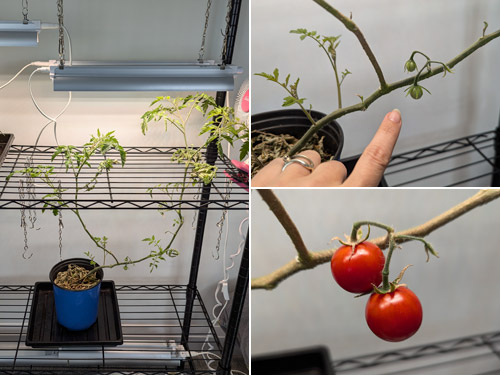 This poor bush tomato did its best indoors, but it really needed a larger pot.
This poor bush tomato did its best indoors, but it really needed a larger pot.
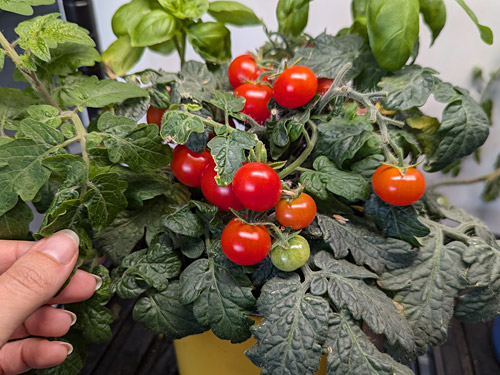 My ‘Tiny Tim’ dwarf is barely 6″ tall, but it’s produced over 30 tomatoes so far and is still growing.
My ‘Tiny Tim’ dwarf is barely 6″ tall, but it’s produced over 30 tomatoes so far and is still growing.
Selecting Varieties
Hybrid vs heirloom – which is better?
I grew a mixture of hybrid and open-pollinated (heirloom) varieties. Open-pollinated tomatoes allow you to save seeds and grow the same plant next year, while hybrids have been bred to offer better traits like vigour, flavour, resilience, at the cost of buying new seeds or plants every year. All my hybrids grew faster and fruited earlier (although this may not be true of all varieties), while the heirlooms generally produced more interesting and unusual-looking fruit. However, some of the heirloom plants were smaller and less productive than the hybrids.
Verdict: Although I love the idea of seed saving, buying new seeds every few years is worth it for special varieties! I plan to keep growing a mixture of hybrids and heirlooms, so I can combine the interest and sustainability of heirlooms with the speed, productivity and flavour of my favourite hybrids.
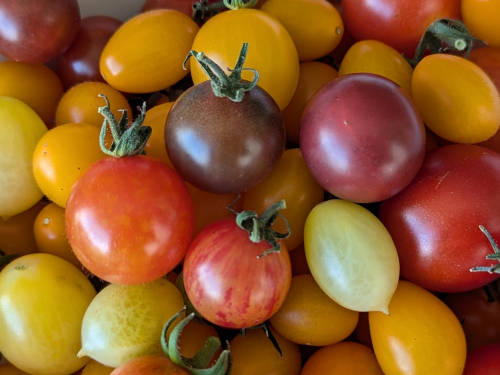 Look at the colours in these heirlooms: brown, purple, lemon yellow, pink-and-orange stripes, peach..!
Look at the colours in these heirlooms: brown, purple, lemon yellow, pink-and-orange stripes, peach..!
Can you save a seed from any tomato?
Saving seeds from an F1 hybrid gives unpredictable results, as the new plant may retain traits from either parent. Last year, a friend had a cherry tomato that sprouted by itself from the seed of a hybrid plant. The resulting second-generation plant was much bigger and stronger than its parent, so I saved seeds from it to see what would happen in the third generation. It can take up to 10 generations to stabilize a new variety, and my results definitely reflect that! Disappointingly, my third-generation plants didn’t inherit the size or vigour of the parent, and the tomato flavour was different too.
Verdict: While it can be fun to save seeds from a delicious tomato, if it was a hybrid, growing those seeds is unlikely to give you the same tomato.
Taste test!
There’s a huge variety in tomato flavour and texture between varieties – sweetness, acidity, juiciness, seediness, etc – and everyone has their own preferences. I’m trying to figure out which tomatoes have the flavours and textures I like best, and (secondarily) have good production and a long harvest period. I can compensate for the secondary factors by growing more plants and selecting varieties with staggered harvests, but I can’t see the point of growing a tomato I don’t really enjoy eating!
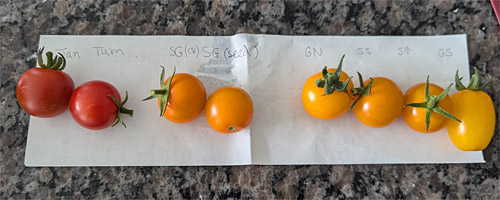
After several tasting sessions to compare and rate all my varieties, I’ve learnt a lot. I thought I was looking for maximum sweetness, but now I know that sweet but mild is too bland for me, and thick skin is a dealbreaker. And colour is not necessarily an indicator of flavour! My ideal tomatoes are full of flavour: sweet, but also balanced with tangy brightness and/or deep complex notes. I’ll be growing my six personal favourites again next year (and testing out a few new ones, let’s not kid ourselves…)
Verdict: If you have the chance, I’d recommend trying a few varieties – you may be surprised by the differences!
Bonus Tip
If you’re growing from seed, remember that the clock begins when you transplant your seedlings outside, so you need to add 42-56 days (that’s 6-8 weeks) to the number of days to harvest stated on the seed packet. A ’55-day’ tomato will take at least 3 months and an ’80-day’ tomato will take about 4 months before you can start harvesting your first fruit..!
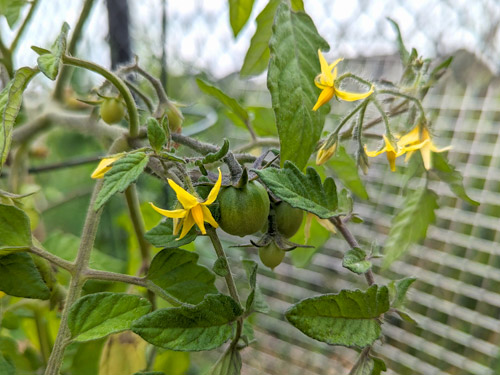
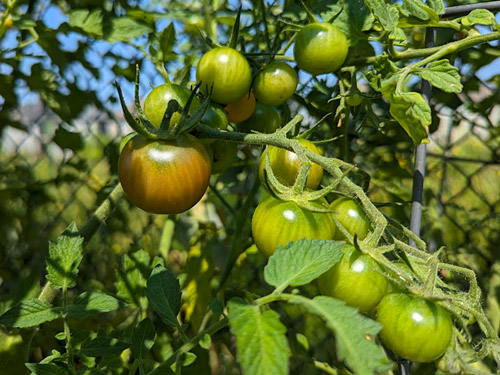
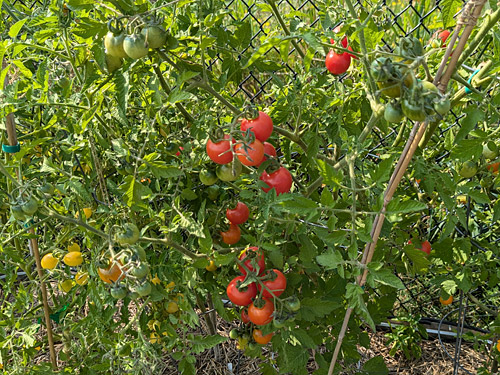
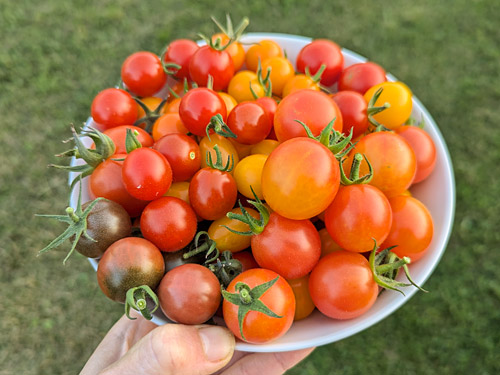 It’s worth the wait, though!
It’s worth the wait, though!
Right now, I’m 80% through my harvesting window (2 more weeks on average till the first frost kills my plants) and I’ve currently picked about 1800 tomatoes, with an approx combined weight of over 13kg (28.5lb).
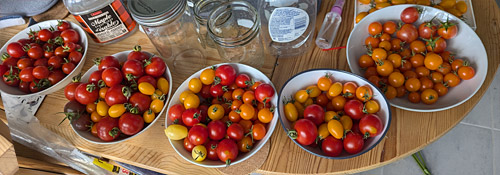
Yes, that’s a lot, and I definitely won’t need to grow 24 tomato plants in future! We’ve eaten tomatoes galore, I’ve made lots of pasta sauce and frozen some for later, I’ve canned enough burger relish to last until next summer, I’ve dehydrated tomatoes to save for later, and I’ll be making a batch of green tomato chutney with all the unripe fruit when the first frost is forecast.
I’m very glad I tried all these experiments this year. Not everything worked out, but now I have a really good idea of how I can get a good yield of especially delicious tomatoes with fewer plants in future. I’m not an expert gardener, and my garden will never be picture-perfect, but it’s so satisfying to be able to enjoy a significant amount of our food that I grew myself, that’s sun-ripened, freshly picked, and free from pesticides and herbicides. You really can taste the difference, and I’m already planning what I’m going to try to grow next year.
Whichever variety you choose, sun-ripened tomatoes fresh from your own garden taste so much better than anything you’ll buy from a grocery store. If you have the opportunity to grow a tomato plant next year, I highly recommend it. But, watch out – once you’ve picked and tasted your own tomatoes you may become tomato obsessed like me!
(And if you believe – as I did just a couple of years ago – that you aren’t capable of growing plants successfully, you can always crochet a plant instead! It won’t taste as good, but it’s guaranteed to never die and always be in bloom…)
















Katy K said
Thanks to your inspiration, I will try growing tomatoes next year, too! I grew flowers in my yard this year, I didn’t think there was enough sun in my backyard, but the flowers did very well, next year I’m putting in a small raised bed so I can try growing tomatoes, and lettuce. Now if only I could grow bacon… 🙂
June said
I’m so glad I’ve inspired you, Katy! Flowers are nice, but getting able to eat what you’ve grown is just magical. Our #gardening Discord channel is going to be fun next year!
Katy K said
Yes, it will! I’m looking forward to it. I think I will purchase my starts rather than grow from seed. I have not had good luck with that before, plus the cat thinks she’s a gardener…I already had to give away all my houseplants because of her!
Cheryl Schlegel said
I love that you documented this! Tomatoes are my love language, and garden tomatoes make me swoon! We have a long growing season in California, but I don’t get very big yields. Time to experiment!
June said
Yay Cheryl, I hope the experiments go well! If I had a long growing season like yours, I’d probably start a second batch of tomatoes mid-season to keep the production going. Fingers crossed for a productive 2025!
RuthL said
Thanks June, I enjoyed that read. 👍🏻
I am currently experimenting with seed grown cherry tomatoes myself. They are very slow growing so far, and my hopes are not terribly high for the outcome. As you said, the roots seem quite shallow when I have separated plants. I notice that there’s another batch of seedlings just coming up now and their siblings are already 6 inches tall. It is just coming into Spring here in the southern hemisphere, and I’m thinking that I may need to cover my raised seed bed with shade cloth when the sun gets too hot. We have had a couple of 30-33 degrees C days here already before September 1. Back to mid 20s again now, but expecting higher temps again next week. Will be interesting to see how they progress and if they ever produce fruit. 🤔
June said
I didn’t realise you’re in the southern hemisphere, Ruth! Shade cloth sounds like a very good idea if you’re expecting a hot summer. And even my weakest-looking seedlings got much stronger once they had the magic combination of sunshine, water, nutrients and space to grow, so I hope yours will do well too, eventually. 🤞
Paula said
This is incredible. thank you for this blog post. I will finally have space for a real garden next year and I’m absolutely coming back to this for guidance on cherry tomatoes!
June said
Yay! We can swap gardening tips in the Discord group 😀